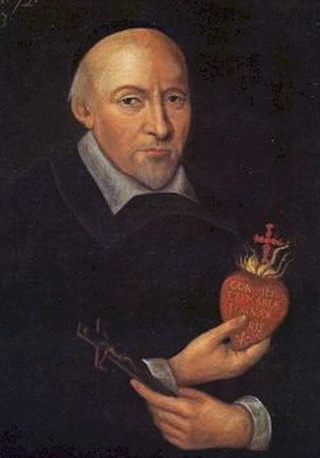
John Eudes, CIM was a French Catholic priest and the founder of both the Order of Our Lady of Charity in 1641 and Congregation of Jesus and Mary, also known as The Eudists, in 1643. He was also a professed member of the Oratory of Jesus until 1643.
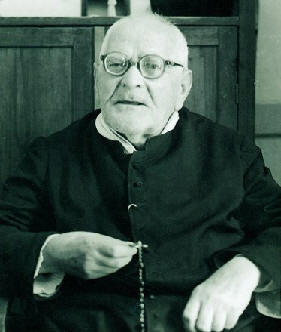
Gaetano Catanoso was an Italian Catholic priest and the founder of the Suore Veroniche del Santo Volto (1934). Catanoso served as a parish priest in two different parishes for his entire ecclesial life and was an ardent devotee of the Face of Jesus which he promoted to the faithful. He also founded the Poor Clerics to encourage vocations to the priesthood while forming the Confraternita del Santo Volto (1920) to spread devotion to the Face of Jesus. He dedicated his pastoral career to bringing the Gospel message to all people and hiked or rode on a mule to reach distant and surrounding mountain villages in order to evangelize to people.

Gesù Nuovo is the name of a church and a square in Naples, Italy. It is located just outside the western boundary of the historic center of the city. To the southeast of the spire, one can see a block away the Fountain of Monteoliveto and the piazza of the church of Sant'Anna dei Lombardi. The square is a result of the expansion of the city to the west beginning in the early 16th century under the rule of Spanish viceroy Pedro Alvarez de Toledo. The square of Gesù Nuovo contains three prominent landmarks:
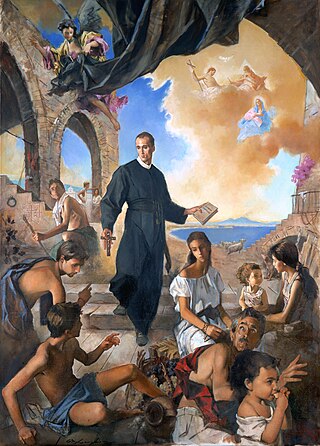
Gennaro Maria Sarnelli was an Italian Roman Catholic priest and a professed member from the Redemptorists. Sarnelli was one of Alphonsus Maria de' Liguori's earliest companions and a prolific writer on a range of religious topics. He wanted to become a Jesuit though was dissuaded from this before working in the Hospital of the Incurables where he call to the priesthood blossomed. His apostolic zeal knew no limits: he preached missions and aided his friend Liguori in his work; he tended to the sick and helped to get girls out of prostitution despite the threats levelled against him.
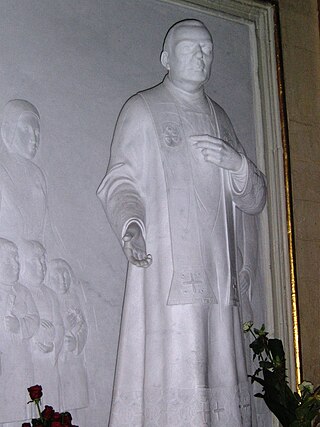
Filippo Smaldone was an Italian Roman Catholic priest and the founder of the Salesian Sisters of the Sacred Hearts. Smaldone is best known for his extensive work with the deaf during his lifetime. Smaldone was a gifted preacher known for his commitment to proper catechesis and to the care of orphans and the mute, which earned him civic recognition.
Giovanni Giovenale Ancina was an Italian Roman Catholic prelate who served as the Bishop of Saluzzo and was a professed member from the Oratorians. The bishop was also a scholar and music composer and was also known for being a noted orator. He served in the Oratorians as a simple priest for around two decades prior to his episcopal appointment which he attempted to elude for five months before submitting to Pope Clement VIII and accepting the papal appointment. He entered his diocese several months later where he became noted for his charitable work with the poor and his efforts to better implement the reforms of the Council of Trent.
Bernardino Realino was an Italian Roman Catholic priest and a professed member of the Jesuits. His entire career was devoted to the areas of Naples and Lecce. Realino pursued a career in law and served in several municipal capacities before feeling called to the Jesuit life and being ordained to the priesthood in Naples. He is often dubbed as the "Apostle of Lecce" for his commitment to the poor and for his preaching abilities.

Gaetano Errico, MSSCC was an Italian Catholic priest from Naples and the founder of the Missionaries of the Sacred Hearts of Jesus and Mary.

Vincenzo Romano – born Vincenzo Domenico Romano – was an Italian Roman Catholic priest born in Torre del Greco in Naples. Romano was a parish priest of the village of Herculano who was noted for his simplistic and frugal manner of living and for his great care of orphans. But the French invaders in his area in addition to some of the Italian political groups oppressed him and his work. The people of Torre del Greco granted him the nickname "The Worker Priest" due to Romano's tireless work with the poor and for his commitment to the social needs of all people in the Neapolitan region. He was also noted for his efforts in rebuilding much of Naples following the 1794 eruption of Mount Vesuvius in which he himself cleared rubble and organized rebuilding efforts.
Paolo Manna was an Italian Roman Catholic priest and a member from the Pontifical Institute for Foreign Missions as well as the founder of the Pontifical Missionary Union. Manna worked in the missions in Burma and even served as the Superior General for PIME. Manna did much in his life to promote the missions and the evangelic and apostolic zeal that accompanied it and he established newspapers and movements to help promote this charismatic apostolate. He also held several leadership positions in PIME and used that standing in order to further engage with prospective missionaries.

Egidio Maria of Saint Joseph - born Francesco Pontillo - was an Italian professed religious of the Order of Friars Minor. Pontillo became a Franciscan brother rather than an ordained priest due to his lack of a proper education and so dedicated himself to the care of the poor and ill in southern Italian cities such as Taranto and Naples where he earned the moniker of the "Consoler of Naples".

The Martyrs of Otranto, also known as Saints Antonio Primaldo and his Companions, were 813 inhabitants of Otranto, Salento, Apulia, in southern Italy, who were killed on 14 August 1480 after the city had fallen to an Ottoman force under Gedik Ahmed Pasha. According to a traditional account, the killings took place after the citizens had refused to convert to Islam.
Francesco Antonio Marcucci was a Roman Catholic Italian bishop and a member of the Secular Franciscan Order. Marcucci was also the founder of the Pious Workers of Mary Immaculate.
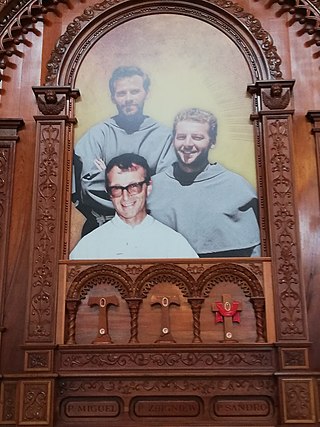
The Three Martyrs of Chimbote were a group of two Polish Franciscan priests and one Italian missionary priest murdered in Peru in 1991 by the Shining Path communist guerillas. Michał Tomaszek and Zbigniew Adam Strzałkowski, and Alessandro Dordi were murdered on 9 August and 25 August 1991 respectively.
Francesco Gattola was an Italian Roman Catholic priest who lived and served in Naples. He was the founder of the Daughters of the Most Holy Immaculate Virgin of Lourdes.
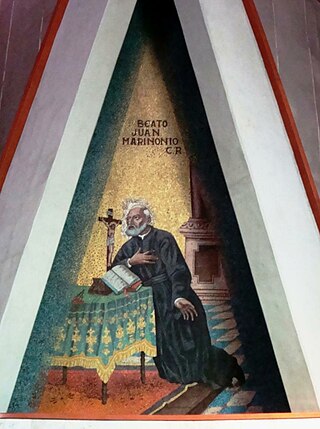
Francesco Marinoni was an Italian Roman Catholic priest who was a member of the Theatines. He assumed the name Giovanni upon his admittance into the order. His cult was confirmed and acted as his formal beatification in 1764 under Pope Clement XIII. His life of heroic virtue was approved and Pope Benedict XVI added the title of Venerable to him despite the fact he was beatified. A miracle - now under investigation - is needed for his canonization.
Francesco Paleari was an Italian priest and a member of the Society of the Priests of Saint Giuseppe Benedetto Cottolengo. He was a noted preacher and was involved in the work of social services to the poor.

Francesco Pianzola was an Italian Roman Catholic priest who established the Missionary Sisters of the Immaculata, Queen of Peace. Pianzola was a preacher who administered to the poor and to children in their own homes; his order dealt with bringing the message of Jesus Christ to the workers and to the poor.

Pompilio Maria Pirrotti, born Domenico Michele Giovan Battista, was an Italian Roman Catholic priest and a professed member of the Piarists. He operated across the Kingdom of Naples as a teacher and as a preacher and he received widespread criticism from detractors that led to his immediate expulsion from the kingdom at the behest of the King. He was later readmitted into the kingdom after public pressure.

The Martyrs of Natal were a group of 30 Roman Catholic people of Colonial Brazil – two of them priests – killed in the northern part of the colony in massacres that a large group of Dutch Calvinists led. One priest was a Colonial Brazilian Jesuit missionary, while the other priest was an evangelizer himself. The others were all lay Catholics, most of them anonymous members of the Church, some of them children.















